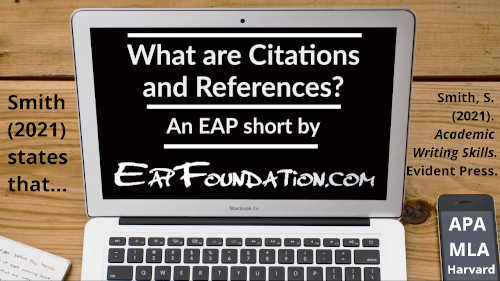Show AWL words on this page.
Show sorted lists of these words.


 







|
The reference section is an important part of a researched academic paper. This page looks at what a reference section is, explains the difference between a reference section and a bibliography, and finally looks at reference section formats for the three most common referencing conventions, namely Harvard, APA (7th edition) and MLA (8th edition).
What is a reference section?
The Reference Section, also called the Reference List or Cited Works List, is a list of the full text (or 'biographical') details of the in-text citations which have used in the main text. It includes information such as author, year of publication, title, and publisher or URL. The Reference Section allows the reader to find the text easily, and can be considered as the long-hand format of the in-text citation. It is found at the end of the piece of writing. It is similar to but not the same as a bibliography (see below). The works in a reference section should be listed in alphabetical order, in other words from A-Z.
Reference Section vs. Bibliography
The format of a reference section and a bibliography will be exactly the same, and will depend on which referencing convention you are using (see main ones below). The difference between them is that a reference section contains only the works which have been cited in the main text. A bibliography, on the other hand, contains additional sources, which the writer has referred to while writing the work but not actually used in the main text. You should check with your tutor which type is required for your submission. Sometimes both are needed: a reference section with works cited, and a separate bibliography which lists works referred to but not used.
Reference section formats
This section gives information on compiling a reference section for the three most common formats, namely Harvard, APA and MLA. This is shown in the same format as you need to use in your reference section (e.g. Title means you need to put the title in italics). Referencing can be a confusing area, with books and websites striving for completeness by considering every possible source of information. To simplify matters, this page considers only the most common sources of information used by students, which are: website articles; journal articles; books; and chapters of edited books.
Harvard
The Harvard style, despite its American origins, is the most common system used in the UK. The following table shows the information needed in the reference section if using the Harvard style of referencing.
| Type of source | Details needed | Notes |
| Website | Surname, Initial1 (Year2) Title. Available at: URL (Accessed: date). | 1) If no author is given, use one of the following (given in order of importance): the name of the organisation,
the name of the website, the title of the web page, the URL (possibly shortened).
2) Webpages do not always give a year of publication. In this case, use (n.d.), which means 'no date'. |
| Journal article | Surname, Initial (Year) 'Title of article', Title of journal, Volume(Issue), page numbers3. | 3) Use p. (short for 'page') or pp. (short for 'pages') to refer to the pages, e.g. pp.109-111. |
| Book | Surname, Initial (Year) Title. Edition4. Place: Publisher. | 4) Only give the edition if it is not the first edition of the book. Use an abbreviation, e.g. 4th edn. |
| Chapter of an edited book | Surname#1, Initial#15 (Year) 'Title of chapter', in Surname#2, Initial#2 (ed.)6 Title of book. Place: Publisher, page numbers. | 5) Surname#1 and Initial#1 belong to the author of the chapter, while Surname#2 and Initial#2 belong to the author or editor of the book.
6) If it is an edited book, the abbreviation (ed.) should be used after the editor's (or editors') name(s). |
Example Reference Section (Harvard style)
Cornell University (2005) What is the difference between documentation, citation, and reference? Available at: https://plagiarism.arts.cornell.edu/tutorial/logistics3.cfm (Access date: 10/11/15).
Leithwood, K., Harris, A., and Hopkins, D. (2008) 'Seven strong claims about successful school leadership', School Leadership & Management, 28(1), pp.27-42.
Pears, R. and Shields, G. (2013) Cite them right: The essential guide to referencing. 9th edn. Basingstoke: Palgrave MacMillan.
Tosey, P. (2003) 'The Learning Organization', in Jarvis, P., Holford, J. and Griffin, C. (eds.) The Theory and Practice of Learning. London: Kogan Page, pp.144-156.
APA
The APA (American Psychological Association) style of referencing is used in social science subjects, especially in the USA. It is very close to the Harvard style. If using APA style, the section is always called References (level 1 heading, meaning it should be in bold and centred). The following table shows the information needed in the reference section if using the APA style of referencing.
| Type of source | Details needed | Notes |
| Website | Surname, Initial1 (Year2). Title. URL | 1) If no author is given, use the title (but do not repeat the title later in the reference). If there is no title, use the URL
2) The year should be the year the site was published, or (if given) the year the webpage was updated. If there is no year, use (n.d.), which means 'no date'. |
| Journal article | Surname, Initial (Year). Title of article. Title of journal, Volume3(Issue), page numbers4. | 3) The Volume number is italicised, but the Issue number is not.
4) For a journal article, p. or pp. is not needed, e.g. 109-111 means 'pages 109-111'. |
| Book | Surname, Initial (Year). Title. Edition5. Publisher. | 5) As with Harvard style, only give the edition if it is not the first edition of the book. |
| Chapter of an edited book | Surname#1, Initial#16 (Year). Title of chapter. In Surname#2, Initial#2 (ed.)7 Title of book (page numbers)8. Publisher. | 6) Surname#1 and Initial#1 belong to the author of the chapter, while Surname#2 and Initial#2 belong to the author or editor of the book.
7) If it is an edited book, the abbreviation (ed.) should be used after the editor's (or editors') name(s). 8) The position of page numbers for APA is different from Harvard style. Unlike for journal articles, p. or pp. should be used, e.g. pp.109-111. |
Example Reference Section (APA style)
Cornell University (2005). What is the difference between documentation, citation, and reference? https://plagiarism.arts.cornell.edu/tutorial/logistics3.cfm
Leithwood, K., Harris, A., and Hopkins, D. (2008). Seven strong claims about successful school leadership. School Leadership & Management, 28(1), 27-42.
Pears, R. and Shields, G. (2013). Cite them right: The essential guide to referencing. 9th edn. Palgrave MacMillan.
Tosey, P. (2003) The Learning Organization. In Jarvis, P., Holford, J. and Griffin, C. (eds.) The Theory and Practice of Learning (pp.144-156). Kogan Page.
MLA
The MLA (Modern Language Association) referencing style is used in some humanities subjects, including language and literature, especially in the USA. The reference section in MLA style is always called the Cited Works List. The following table shows the information needed in the reference section if using the MLA style of referencing.
| Type of source | Details needed | Notes |
| Website | Surname, Forename1. Title. Year2. URL3. Access date. | 1) Unlike for Harvard and APA, the MLA style requires the forename of the author, not initials.
If there is more than one author, only the first is reversed (the second and subsequent authors will be listed as Forename Surname).
2) Use the year the site was published or last updated. If there is no year, use N.d. 3) The URL should be included without https:// or http:// |
| Journal article | Surname, Forename. "Title of article."4 Title of journal, Volume.Issue (Year): page numbers5. | 4) As this is an American system, double quotation marks (" ") should be used.
5) Unlike with the Harvard system, p. or pp. is not used to refer to the pages, e.g. 109-111 means 'pages 109-111'. |
| Book | Surname, Forename. Title. Edition6. Place7: Publisher, Year. | 6) Only give the edition if it is not the first edition of the book. 7) Place is only used for books published before 1900, if the publisher has offices in more than one country, or if the publisher is unknown in the USA. |
| Chapter of an edited book | Surname#1, Forename#18. "Title of chapter." Title of book. Ed.9 Forename#2 Surname#210. Place: Publisher, Year, page numbers. | 8) Surname#1 and Forename#1 belong to the author of the chapter, while Surname#2 and Forename#2 belong to the author or editor of the book.
9) If it is an edited book, the abbreviation Ed. should be used before the editor's (or editors') name(s). 10) For the book editor(s), it is not necessary to reverse the surname and forename. |
Example Cited Works List (MLA style)
Cornell University. What is the difference between documentation, citation, and reference? 2005. plagiarism.arts.cornell.edu/tutorial/logistics3.cfm. Accessed 10 November 2015.
Leithwood, Kenneth, Alma Harris and David Hopkins. "Seven strong claims about successful school leadership." School Leadership & Management. 28.1 (2008): 27-42.
Pears, Richard and Graham Shields. Cite them right: The essential guide to referencing. 9th edn. Basingstoke: Palgrave MacMillan, 2013.
Tosey, Paul. "The Learning Organization". The Theory and Practice of Learning. Ed. Peter Jarvis, John Holford, and Colin Griffin. London: Kogan Page, 2003, 144-156.
Multiple authors
As mentioned in the in-text citations section, one area of difference between the above styles is how they deal with multiple authors. For the Harvard style, all authors are listed in the reference section, no matter how many there are. With APA style, up to 20 authors' names are listed; if more than 20, use ... after the 19th name, followed by the final author's name. With MLA style, if the phrase et al. is used for multiple authors in the text, then only the first author and the phrase et al. is given in the Cited Works List.
Checklist
Below is a checklist for checking the reference section of an academic paper. Use it to check your own writing, or get a peer (another student) to help you.
| Area | Item | OK? | Note/comment |
| General format | The reference section has an appropriate heading (e.g. Reference Section, Reference List, References if APA style is used, or Cited Works List if MLA style is used). | ||
| The reference section is in alphabetical (A-Z) order. | |||
| Completeness | The reference section contains only the sources in the text (unless is it a Bibliography). | ||
| The reference section contains all the sources in the text. | |||
| Specific format | Appropriate format is used for authors' names, i.e. Surname, Initial (for Harvard or APA) or Surname, Forename (for MLA). | ||
| Appropriate format is used for titles, including italics and single/double quotation marks. | |||
| Appropriate format is used for year. If there is no year (e.g. internet sources), then (n.d.) (for Harvard and APA styles) or N.d. (for MLA style) has been used. | |||
| For book sources, the place and publisher have been given in the appropriate format (if APA style is used, the place includes the two digit state code for US sources, or country name for non-US sources). | |||
| For journal articles, the volume and issue number have been given, along with page numbers. | |||
| For internet sources, the URL has been given (unless MLA format is used, in which case it has been omitted). |
References
American Psychological Association (2016) How do you cite website material that has no author, no year, and no page numbers? Available at: http://www.apastyle.org/learn/faqs/cite-website-material.aspx (Access date: 1/1/2016).
Leabharlann, A., Ollsciole, A., and Cliath, B.(2011) MLA Referencing Style. Available at: http://www.ucd.ie/t4cms/Guide70.pdf (Access date: 31/12/2015).
Pears, R. and Shields, G. (2013). Cite them right: The essential guide to referencing. 9th edn. Basingstoke: Palgrave MacMillan.
Russell, T., Brizee, A., Angeli, E., Keck, R., Paiz, J., Campbell, M., Rodríguez-Fuentes, R., and Kenzie, D. (2014) MLA In-Text Citations: The Basics. Available at: https://owl.english.purdue.edu/owl/resource/747/02/ (Access date: 31/12/2015).
Southern Cross University (2014) Harvard Referencing Style. Available at: http://libguides.scu.edu.au/content.php?pid=269507&sid=2223231 (Access date: 1/1/2016).
University of Maryland University College (2016) MLA Citation Examples. Available at: http://www.umuc.edu/library/libhow/mla_examples.cfm. (Access date: 1/1/2016).
Next section
Find out about reporting verbs in the next section.
Previous section
Go back to the previous section about in-text citations.






